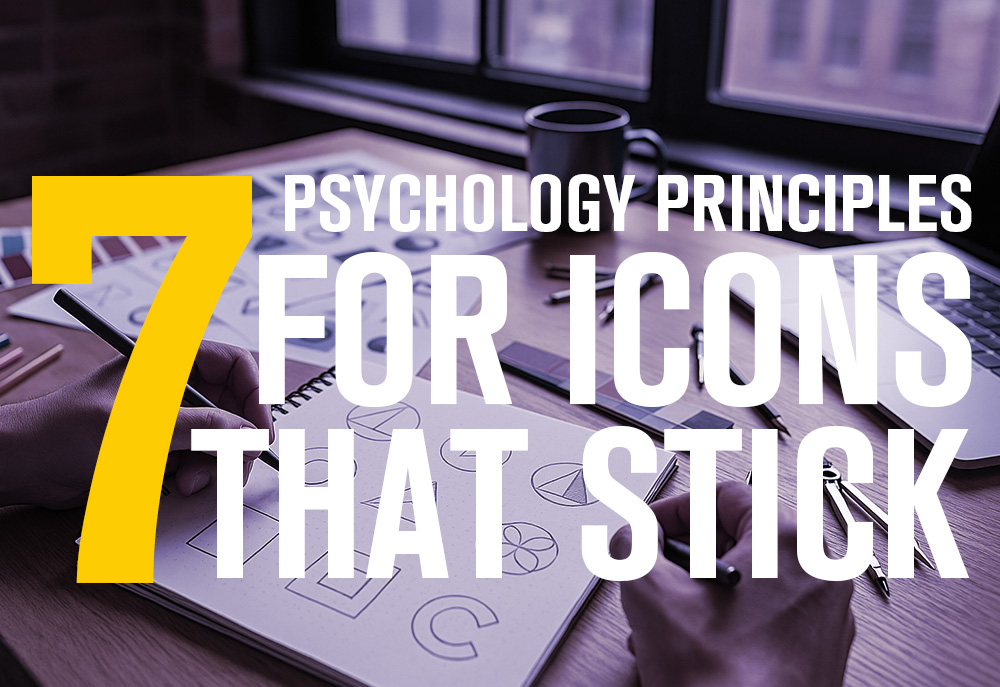1) Shape language: feelings before words
Before anyone reads your name, the shape speaks.
Circles/ovals → warmth, community, motion.
Squares/rectangles → stability, structure, trust.
Triangles/chevrons → direction, energy, change.
Pick a dominant geometry that fits your brand promise, then keep it consistent across your system (primary mark, favicon, app icon). In logo design NYC, we also watch for clashes with well-known local marks (sports teams, transit icons) to stay ownable.
2) Processing fluency: simple = memorable
The brain prefers symbols it can process quickly. Remove details that don’t help recognition. Your icon should pass the silhouette test (filled in black), the favicon test (16–32 px), and the arm’s-length test (seen from 2–3 meters). If it works in these constraints, it will work on a crowded Avenue of the Americas billboard or a tiny social avatar.
Our brains connect and complete shapes automatically. Use closure (suggest, don’t draw), proximity (group elements), and continuity (smooth implied lines) to build clever, compact symbols. The trick is balance: enough suggestion to feel smart, not so much that the mark becomes a puzzle.
4) Figure–ground & contrast: instant read in any context
A logo should pop on light and dark. Design with strong figure–ground separation and a clear contrast ratio. Test on real NYC backdrops—subway signage blacks, street-poster neons, sunlit glass. If the icon disappears on busy photography, add a holding shape or outline. This is where many DIY marks fail, and where custom logo design services save weeks of rework. Check figure–ground and contrast ratios with
WebAIM’s Contrast Checker.
5) Color with intent (and backups)
Color is a shortcut to emotion, but it’s also context-dependent.
Finance/healthcare in NYC often lean toward blues/teals (trust, clarity).
Food & hospitality can own warm hues (appetite, energy).
Tech leans cool + vibrant accents (innovation).
Build an accessible primary palette, then define one-color and duotone fallbacks. Your logo must still be itself in grayscale on invoices, stamps and etched glass.
6) Category cues + distinctive twist
People need to know what you are, fast—so nod to your category (a subtle medical cross, a construction angle, a craft script for a bakery). Then add a fresh twist: an unexpected negative space, an unusual angle, a custom terminal. This mix—familiar plus ownable—is what makes marks stick in saturated markets like New York.
7) Name–symbol lockup: make it sing together
Icons don’t live alone. Pair your symbol with a wordmark that has rhythm and spacing to match. Custom kerning and micro-adjusted letterforms create a “one piece” feel. Consider a responsive system: full lockup (horizontal), stacked version, symbol-only, and a square social avatar. When you hire custom logo design services, ask for these sizes, safe-areas and minimum-size rules in the brand guide.
NYC reality check: constraints we always test
Five-second test: can strangers say what you do after 5 seconds?
Squint/blur test: does the shape still read when details vanish?
Black-and-white test: does it hold up without color?
Dark-mode test: invert UI; does the mark remain crisp?
Motion test: does a simple micro-animation (fade, rotate, reveal) enhance recognition without gimmicks?
Trademark & lookalike sweep: scan for conflicts in your class; NYC brands can’t risk confusion.
Run a quick clearance search via WIPO Global Brand Database and the US USPTO trademark search.
Our process for NYC brands
Discovery & positioning — audience, category codes, personality traits.
Moodboards & shape studies — geometry choices, contrast scenarios, color exploration.
Sketch → vector — from dozens of napkin ideas to 3–5 refined routes.
Stress tests — all the checks above, plus real-world mockups (signage, app, storefront).
System build — primary/alt marks, clearspace, min sizes, color/mono, icon set.
Handover — SVG/AI/PNG, usage guide, and a roadmap for rollout.
This approach turns logo design NYC from guesswork into a repeatable system that scales.
Quick checklist (save this)
One dominant shape language (circle/square/triangle)
Passes silhouette, favicon and arm’s-length tests
Strong figure–ground; works on light & dark
Accessible palette + 1-color fallback
Category cue + distinctive twist
Responsive lockups (horizontal, stacked, icon)
Clear rules (safe-area, min size, misuse)





